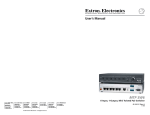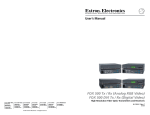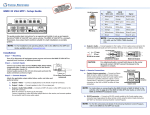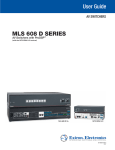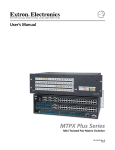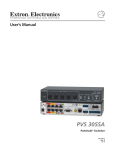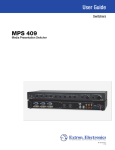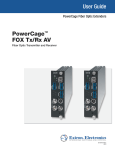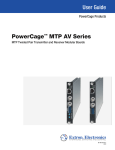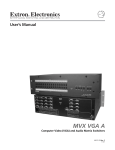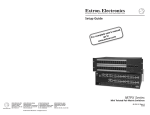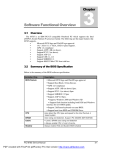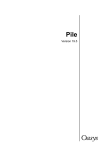Download MTP SW6 User Manual - Extron Electronics
Transcript
User Manual
Twisted Pair
MTP SW6
Six Input MTP Twisted Pair Switcher
68-1462-01 Rev. B
02 10
Safety Instructions • English
Warning
This symbol is intended to alert the user of important operating and maintenance (servicing) instructions in the literature provided with the equipment.
Power sources • This equipment should be operated only from the power source indicated on the product. This
equipment is intended to be used with a main power system with a grounded (neutral) conductor. The third
(grounding) pin is a safety feature, do not attempt to bypass or disable it.
This symbol is intended to alert the user of the presence of uninsulated
dangerous voltage within the product’s enclosure that may present a risk of
electric shock.
Power disconnection • To remove power from the equipment safely, remove all power cords from the rear of
the equipment, or the desktop power module (if detachable), or from the power source receptacle (wall plug).
Caution
Read Instructions • Read and understand all safety and operating instructions before using the equipment.
Retain Instructions • The safety instructions should be kept for future reference.
Follow Warnings • Follow all warnings and instructions marked on the equipment or in the user information.
Avoid Attachments • Do not use tools or attachments that are not recommended by the equipment
manufacturer because they may be hazardous.
Consignes de Sécurité • Français
Ce symbole sert à avertir l’utilisateur que la documentation fournie avec le
matériel contient des instructions importantes concernant l’exploitation et la
maintenance (réparation).
Ce symbole sert à avertir l’utilisateur de la présence dans le boîtier
de l’appareil de tensions dangereuses non isolées posant des risques
d’électrocution.
Attention
Lire les instructions• Prendre connaissance de toutes les consignes de sécurité et d’exploitation avant
d’utiliser le matériel.
Conserver les instructions• Ranger les consignes de sécurité afin de pouvoir les consulter à l’avenir.
Respecter les avertissements • Observer tous les avertissements et consignes marqués sur le matériel ou
présentés dans la documentation utilisateur.
Power cord protection • Power cords should be routed so that they are not likely to be stepped on or pinched
by items placed upon or against them.
Servicing • Refer all servicing to qualified service personnel. There are no user-serviceable parts inside. To prevent
the risk of shock, do not attempt to service this equipment yourself because opening or removing covers may
expose you to dangerous voltage or other hazards.
Slots and openings • If the equipment has slots or holes in the enclosure, these are provided to prevent
overheating of sensitive components inside. These openings must never be blocked by other objects.
Lithium battery • There is a danger of explosion if battery is incorrectly replaced. Replace it only with the
same or equivalent type recommended by the manufacturer. Dispose of used batteries according to the
manufacturer’s instructions.
Eviter les pièces de fixation • Ne pas utiliser de pièces de fixation ni d’outils non recommandés par le fabricant
du matériel car cela risquerait de poser certains dangers.
Avertissement
Alimentations • Ne faire fonctionner ce matériel qu’avec la source d’alimentation indiquée sur l’appareil. Ce
matériel doit être utilisé avec une alimentation principale comportant un fil de terre (neutre). Le troisième
contact (de mise à la terre) constitue un dispositif de sécurité : n’essayez pas de la contourner ni de la
désactiver.
Déconnexion de l’alimentation• Pour mettre le matériel hors tension sans danger, déconnectez tous les
cordons d’alimentation de l’arrière de l’appareil ou du module d’alimentation de bureau (s’il est amovible) ou
encore de la prise secteur.
Protection du cordon d’alimentation • Acheminer les cordons d’alimentation de manière à ce que personne
ne risque de marcher dessus et à ce qu’ils ne soient pas écrasés ou pincés par des objets.
Réparation-maintenance • Faire exécuter toutes les interventions de réparation-maintenance par un
technicien qualifié. Aucun des éléments internes ne peut être réparé par l’utilisateur. Afin d’éviter tout danger
d’électrocution, l’utilisateur ne doit pas essayer de procéder lui-même à ces opérations car l’ouverture ou le
retrait des couvercles risquent de l’exposer à de hautes tensions et autres dangers.
Fentes et orifices • Si le boîtier de l’appareil comporte des fentes ou des orifices, ceux-ci servent à empêcher les
composants internes sensibles de surchauffer. Ces ouvertures ne doivent jamais être bloquées par des objets.
Sicherheitsanleitungen • Deutsch
Lithium Batterie • Il a danger d’explosion s’ll y a remplacment incorrect de la batterie. Remplacer uniquement
avec une batterie du meme type ou d’un ype equivalent recommande par le constructeur. Mettre au reut les
batteries usagees conformement aux instructions du fabricant.
Vorsicht
Dieses Symbol soll dem Benutzer in der im Lieferumfang enthaltenen
Dokumentation besonders wichtige Hinweise zur Bedienung und Wartung
(Instandhaltung) geben.
Stromquellen • Dieses Gerät sollte nur über die auf dem Produkt angegebene Stromquelle betrieben werden.
Dieses Gerät wurde für eine Verwendung mit einer Hauptstromleitung mit einem geerdeten (neutralen) Leiter
konzipiert. Der dritte Kontakt ist für einen Erdanschluß, und stellt eine Sicherheitsfunktion dar. Diese sollte nicht
umgangen oder außer Betrieb gesetzt werden.
Dieses Symbol soll den Benutzer darauf aufmerksam machen, daß im Inneren
des Gehäuses dieses Produktes gefährliche Spannungen, die nicht isoliert sind
und die einen elektrischen Schock verursachen können, herrschen.
Stromunterbrechung • Um das Gerät auf sichere Weise vom Netz zu trennen, sollten Sie alle Netzkabel aus der
Rückseite des Gerätes, aus der externen Stomversorgung (falls dies möglich ist) oder aus der Wandsteckdose
ziehen.
Achtung
Lesen der Anleitungen • Bevor Sie das Gerät zum ersten Mal verwenden, sollten Sie alle Sicherheits-und
Bedienungsanleitungen genau durchlesen und verstehen.
Aufbewahren der Anleitungen • Die Hinweise zur elektrischen Sicherheit des Produktes sollten Sie
aufbewahren, damit Sie im Bedarfsfall darauf zurückgreifen können.
Befolgen der Warnhinweise • Befolgen Sie alle Warnhinweise und Anleitungen auf dem Gerät oder in der
Benutzerdokumentation.
Keine Zusatzgeräte • Verwenden Sie keine Werkzeuge oder Zusatzgeräte, die nicht ausdrücklich vom
Hersteller empfohlen wurden, da diese eine Gefahrenquelle darstellen können.
Instrucciones de seguridad • Español
Este símbolo se utiliza para advertir al usuario sobre instrucciones importantes de operación y mantenimiento (o cambio de partes) que se desean
destacar en el contenido de la documentación suministrada con los equipos.
Este símbolo se utiliza para advertir al usuario sobre la presencia de elementos con voltaje peligroso sin protección aislante, que puedan encontrarse
dentro de la caja o alojamiento del producto, y que puedan representar
riesgo de electrocución.
Precaucion
Leer las instrucciones • Leer y analizar todas las instrucciones de operación y seguridad, antes de usar el
equipo.
Conservar las instrucciones • Conservar las instrucciones de seguridad para futura consulta.
Obedecer las advertencias • Todas las advertencias e instrucciones marcadas en el equipo o en la
documentación del usuario, deben ser obedecidas.
安全须知 • 中文
这个符号提示用户该设备用户手册中有重要的操作和维护说明。
这个符号警告用户该设备机壳内有暴露的危险电压,有触电危险。
注意
阅读说明书 • 用户使用该设备前必须阅读并理解所有安全和使用说明。
保存说明书 • 用户应保存安全说明书以备将来使用。
遵守警告 • 用户应遵守产品和用户指南上的所有安全和操作说明。
避免追加 • 不要使用该产品厂商没有推荐的工具或追加设备,以避免危险。
Schutz des Netzkabels • Netzkabel sollten stets so verlegt werden, daß sie nicht im Weg liegen und niemand
darauf treten kann oder Objekte darauf- oder unmittelbar dagegengestellt werden können.
Wartung • Alle Wartungsmaßnahmen sollten nur von qualifiziertem Servicepersonal durchgeführt werden.
Die internen Komponenten des Gerätes sind wartungsfrei. Zur Vermeidung eines elektrischen Schocks
versuchen Sie in keinem Fall, dieses Gerät selbst öffnen, da beim Entfernen der Abdeckungen die Gefahr eines
elektrischen Schlags und/oder andere Gefahren bestehen.
Schlitze und Öffnungen • Wenn das Gerät Schlitze oder Löcher im Gehäuse aufweist, dienen diese zur
Vermeidung einer Überhitzung der empfindlichen Teile im Inneren. Diese Öffnungen dürfen niemals von
anderen Objekten blockiert werden.
Litium-Batterie • Explosionsgefahr, falls die Batterie nicht richtig ersetzt wird. Ersetzen Sie verbrauchte Batterien
nur durch den gleichen oder einen vergleichbaren Batterietyp, der auch vom Hersteller empfohlen wird.
Entsorgen Sie verbrauchte Batterien bitte gemäß den Herstelleranweisungen.
Evitar el uso de accesorios • No usar herramientas o accesorios que no sean especificamente recomendados
por el fabricante, ya que podrian implicar riesgos.
Advertencia
Alimentación eléctrica • Este equipo debe conectarse únicamente a la fuente/tipo de alimentación eléctrica
indicada en el mismo. La alimentación eléctrica de este equipo debe provenir de un sistema de distribución
general con conductor neutro a tierra. La tercera pata (puesta a tierra) es una medida de seguridad, no
puentearia ni eliminaria.
Desconexión de alimentación eléctrica • Para desconectar con seguridad la acometida de alimentación
eléctrica al equipo, desenchufar todos los cables de alimentación en el panel trasero del equipo, o desenchufar
el módulo de alimentación (si fuera independiente), o desenchufar el cable del receptáculo de la pared.
Protección del cables de alimentación • Los cables de alimentación eléctrica se deben instalar en lugares
donde no sean pisados ni apretados por objetos que se puedan apoyar sobre ellos.
Reparaciones/mantenimiento • Solicitar siempre los servicios técnicos de personal calificado. En el interior no
hay partes a las que el usuario deba acceder. Para evitar riesgo de electrocución, no intentar personalmente la
reparación/mantenimiento de este equipo, ya que al abrir o extraer las tapas puede quedar expuesto a voltajes
peligrosos u otros riesgos.
Ranuras y aberturas • Si el equipo posee ranuras o orificios en su caja/alojamiento, es para evitar el
sobrecalientamiento de componentes internos sensibles. Estas aberturas nunca se deben obstruir con otros
objetos.
Batería de litio • Existe riesgo de explosión si esta batería se coloca en la posición incorrecta. Cambiar esta
batería únicamente con el mismo tipo (o su equivalente) recomendado por el fabricante. Desachar las baterías
usadas siguiendo las instrucciones del fabricante.
警告
电源 • 该设备只能使用产品上标明的电源。 设备必须使用有地线的供电系统供电。 第三条线
(地线)是安全设施,不能不用或跳过 。
拔掉电源 • 为安全地从设备拔掉电源,请拔掉所有设备后或桌面电源的电源线,或任何接到市
电系统的电源线。
电源线保护 • 妥善布线, 避免被踩踏,或重物挤压。
维护 • 所有维修必须由认证的维修人员进行。 设备内部没有用户可以更换的零件。为避免出现
触电危险不要自己试图打开设备盖子维修该设备。
通风孔 • 有些设备机壳上有通风槽或孔,它们是用来防止机内敏感元件过热。 不要用任何东
西挡住通风孔。
锂电池 • 不正确的更换电池会有爆炸的危险。必须使用与厂家推荐的相同或相近型号的电池。
按照生产厂的建议处理废弃电池。
FCC Class A Notice
This equipment has been tested and found to comply with the limits for a Class A digital device, pursuant to part 15
of the FCC Rules. Operation is subject to the following two conditions:
1. This device may not cause harmful interference.
2. This device must accept any interference received, including interference that may cause undesired operation.
The Class A limits are designed to provide reasonable protection against harmful interference when the equipment
is operated in a commercial environment. This equipment generates, uses, and can radiate radio frequency energy
and, if not installed and used in accordance with the instruction manual, may cause harmful interference to radio
communications. Operation of this equipment in a residential area is likely to cause harmful interference, in which
case the user will be required to correct the interference at his own expense.
Copyright
© 2010 Extron Electronics. All rights reserved.
Trademarks
All trademarks mentioned in this manual are the properties of their respective owners.
Contents
Introduction............................................. 1
Remote Control....................................... 19
About this Manual............................................ 1
About the MTP SW6 Switcher........................... 1
RS-232 Function........................................... 2
Twisted Pair (TP) Cable Advantages............... 3
Features............................................................ 5
Simple Instruction Set™ Control....................... 20
Host-to-Interface Communications.............. 20
Symbol Definitions...................................... 20
Unit-Initiated Messages............................... 21
Error Responses.......................................... 21
Timeout...................................................... 22
Using the Command/Response Table........... 22
Command/response Table
for SIS Commands...................................... 23
Windows-Based Program Control................... 26
Installing the Software................................ 26
Using the Software..................................... 27
Contact Closure Remote Control.................... 27
IR 102 Infrared Remote Control...................... 28
Installation and Operation...................... 6
Mounting the MTP SW6................................... 6
Tabletop Use................................................. 6
Rack Shelf Mounting..................................... 6
Furniture Mounting....................................... 8
Connectors and Settings................................... 9
Making Connections................................... 12
Receiver Considerations.............................. 14
Operation....................................................... 15
Switch Mode.............................................. 16
Optimizing the Video...................................... 17
Level/Peaking Setting.................................. 17
Skew Delay Compensation.......................... 18
Reference Information........................... 29
Specifications.................................................. 29
Part Numbers.................................................. 31
Included Parts............................................. 31
Accessories................................................. 31
Cables........................................................ 31
Connectors................................................. 32
MTP SW6 • Contents
iv
Introduction
This section gives an overview of the manual and describes the Extron® MTP SW6 and its
features, including:
• About this Manual
• About the MTP SW6 Switcher
• Features
About this Manual
This manual describes the function, installation, configuration, and operation of the
MTP SW6 twisted pair switcher.
About the MTP SW6 Switcher
The Extron MTP SW6 is a 6-input, 1-output twisted pair switcher that is compatible with the
entire line of Extron MTP transmitters and receivers.
The Extron MTP transmitters and receivers are a system for long-distance distribution of
video and either audio or RS-232 communications. The MTPs transmit and receive over
Extron Enhanced Skew-Free™ A/V UTP cable or over CAT 5, 5e, or 6 shielded twisted pair
(STP), unshielded twisted pair (UTP), or foil shielded twisted pair (FTP) cable.
The MTP switcher receives up to six sets of signals from compatible MTP devices on
RJ-45 connectors (figure 1). You can select one input to output to a compatible MTP device
on an RJ-45 connector. The signal sets are comprised of high or low resolution video signals
(RGB, bi-level or tri-level component video, S-video, or composite video) and can also include
either RS-232 serial signals or audio.
TouchLink™
Control
System
VCR
DVD
DOC
CAM
LAPTOP
PC
ON
OFF
DISPLAY
MUTE
SCREEN
UP
SCREEN
DOWN
Extron
SI 28
Surface-mount
Speakers
TCP/IP
XPA
1
100
INPUT
IR
RX
RELAY
LINK
3
ACT
OVER
TEMP
LIMITEL
SIGNA
1
4
4
2
1
4
2
R
2
1
TX
250
R/PRO
3
1
3
COM
IPL
2
Power
Amplifier
2
3
Switcher
Control
P
MT
1002
Extron
XPA 1002
TECT
®
6
SW
Audio
TE
MO
RE
2
-23
RS RT
INSE
RE
SPA
Tx
UTE-PEA
K
TP
OU
PR
Display
Control
UT
TP
OU
DIO R
Rx
2
-23
RS
CE
SPA
AU
S
NOL
TP
OU
WE
6
PO
WE
PO
12VA MA
0.5
2
X
UT
INP
YUV
Extron
MTP U R RSA SEQ
4
3
R
Extron
MTP SW6
RS-232
B
RG
X
12VA MA
0.5
5
RGBHV
Universal Receiver
1
S-video
Y/C
R
T
DIO
AU 2
B-Y
Y
R-Y
PU
NO
MO
1
VID
F
OF
IN
Rx
Tx
UT
MO
ON
Mini Twisted Pair
Switcher
Flat Panel
Display
DIO
with Speakers
Extron
MTP T 15HD A WM
IN
AU
ER
IN
UT
Transmitter
MP
CO
T
R
INPU
L
PT
Transmitter
HD
A
15
MT
X
DA
IN
PT
Extron
MTP T SV A
VID
S-
R
UTE
MP
CO IN
IO
AUD
UT
TP A
OU SV
T
EO MTP
12Va MA
0.5
15H
MT
DIO
IN
AU
ER
Blu-ray Player
IN
UT
MP
CO
Extron
MTP T 15HD A
AAP
DVD
Transmitter
Laptop
Extron
MTP T 15HD A D
Transmitter
Laptop
Figure 1. Typical MTP SW6 application
MTP SW6 • Introduction
1
NOTE: The remote power capabilities of certain MTP models are not supported by this
switcher.
The MTP switcher has image enhancement features that allow you to correct for long
distance transmissions and skew:
• Level and Peaking controls enhance the TP signals received on the inputs.
• A Pre-Peaking control enhances the TP output for optimum display.
• Delay (skew correction) controls correct for skew delay (misconvergence) commonly
encountered when using CAT 5, 5e, or 6 TP cables for RGB video, and component
video transmission.
NOTE: Skew correction should not be necessary when Extron Enhanced Skew-Free
A/V UTP cable is used and the transmission distance is less than 1,000 feet
(300 m).
Bidirectional RS-232 signal from a dedicated source (rather than from the selected input)
can be directly inserted into the signal set routed to the TP output. You can even route
RS-232 on a link that is normally audio, such as to an MTP R 15HD RSA D receiver, which
can autodetect whether the signal input to it includes an audio component or an RS-232
component.
The MTP switcher is housed in a rack-mountable, 1U high, half rack-width metal
enclosure. This switcher is shipped with an external 12 V power supply that accepts 100
to 240 VAC, 50 Hz or 60 Hz input and provides worldwide power compatibility.
RS-232 Function
When the TP link includes RS-232 signals, they are unidirectional (switcher to receiver).
NOTE: The RS-232 insert signal path is bidirectional.
The RS-232 link:
• Supports software flow control (XON, XOFF).
NOTE: Hardware flow control is not supported.
• Supports full duplex and half duplex operation.
• Supports baud rates up to 38,400, data bits, parity, stop bits, and data format without
configuration.
NOTE: Higher rates are possible, but performance will vary as a function of baud
rate and TP cable length.
MTP SW6 • Introduction
2
Twisted Pair (TP) Cable Advantages
Twisted pair cable is much smaller, lighter, more flexible, and less expensive than coaxial
cable. These TP products make cable runs simpler and less cumbersome. Termination of
the cable with RJ-45 connectors is simple, quick, and economical.
Transmission distance
NOTE: VGA video transmitters provide pre-peaking, which boosts the signal before it is
transmitted.
The maximum distance is determined by the frequency and resolution of the signal that
is input to the transmitter. Figure 2 and Table 1, on the next page, define the switcher
input cables ( 1 ) and output cables ( 2 ) and specify the recommended maximum
transmission distances on the input and output. Table 1 also defines the output Pre-Peak
switch positions (item d on page 10) using Extron Enhanced Skew-Free A/V UTP cable or
UTP CAT 5, 5e, or 6 cable, terminated with RJ-45 connectors.
NOTES: • It is possible to exceed the recommended distance; however, image quality
may be reduced.
• The MTP units are designed for and perform best with Extron Enhanced
Skew-Free A/V cable terminated in accordance with the TIA/EIA T 568
A wiring standard. CAT 5, 5e, and 6 cables are acceptable, but less
preferable. We also recommend the use of preterminated and tested
cables. Cables terminated on site should be tested before use to ensure
that they comply with Category 5 specifications.
• Resolutions marked with an asterisk in table 1 have the same range
specifications at 75 Hz.
MTP SW6 • Introduction
3
MTP T 15HD A
AUDIO
PRE-PEAK
POWER
12V
.5A MAX
ON
INPUT
MONITOR
OFF
MTP Transmitter
MTP Receiver
1
OUTPUT
OUTPUTS
MTP U R A
POWER
VID
12V
0.5A MAX
OUTPUT
INPUT
POWER
12V
0.5A MAX
PRE-PEAK
ON
Tx Rx
SPARE
RGB
INPUT
MTP SW6
RS-232
INSERT
MONO AUDIO
L
R
Y/C
REMOTE
MONO AUDIO OUTPUT
L
R
OFF
1
2
3
4
5
6
2
Figure 2. Transmission cables
Table 1. Recommended transmission distances at 60 Hz
Video
format
MTP SW6 Pre-Peak
High quality
Variable quality
Off
On
Component,
S-video,
composite
<300' (90 m)
>350' (105 m)
700' (215 m)
700 (215 m)
700' (215 m)
800 (245 m)
640 x 480
<300' (90 m)
>350' (105 m)
550' (170 m)
600' (185 m)
550' (170 m)
700' (215 m)
800 x 600
<300' (90 m)
>350' (105 m)
500' (150 m)
500' (150 m)
600' (185 m)
600' (185 m)
Input
1
Output
2
Input
1
Output
2
1024 x 768*
<300' (90 m)
>350' (105 m)
450' (135 m)
450' (135 m)
550' (170 m)
550' (170 m)
1280 x 960*
<300' (90 m)
>350' (105 m)
350' (105 m)
350' (105 m)
450' (135 m)
450' (135 m)
1280 x 1024*
<250' (75 m)
>300' (90 m)
350' (105 m)
350' (105 m)
450' (135 m)
450' (135 m)
1360 x 765
<250' (75 m)
>300' (90 m)
350' (105 m)
350' (105 m)
500' (150 m)
500' (150 m)
1365 x 768
<250' (75 m)
>300' (90 m)
350' (105 m)
350' (105 m)
450' (135 m)
450' (135 m)
1366 x 768
<250' (75 m)
>300' (90 m)
350' (105 m)
350' (105 m)
450' (135 m)
450' (135 m)
1440 x 900
<250' (75 m)
>300' (90 m)
350' (105 m)
300' (90 m)
400' (120 m)
400' (120 m)
1400 x 1050
<250' (75 m)
>300' (90 m)
350' (105 m)
300' (90 m)
400' (120 m)
400' (120 m)
1600 x 1200*
<250' (75 m)
>300' (90 m)
300' (90 m)
300' (90 m)
450' (135 m)
450' (135 m)
1920 x 1200
<250' (75 m)
>300' (90 m)
300' (90 m)
250' (75 m)
400' (120 m)
400' (120 m)
HDTV 720p
<250' (75 m)
>300' (90 m)
400' (120 m)
400' (120 m)
500' (150 m)
500' (150 m)
HDTV 1080i
<250' (75 m)
>300' (90 m)
300' (90 m)
250' (75 m)
400' (120 m)
400' (120 m)
HDTV 1080p
<250' (75 m)
>300' (90 m)
300' (90 m)
250' (75 m)
400' (120 m)
400' (120 m)
MTP SW6 • Introduction
4
Features
Compatible with all Extron MTP Series Twisted Pair products — Broad compatibility
with all MTP products enables design flexibility when selecting components, and allows
the use of an economical CAT 5-type cable infrastructure for A/V system integration.
Dynamic input skew equalization — Adjustments are stored in memory for each input,
maintaining RGB color alignment at all times.
Video level and peaking compensation on each input — Actively compensates for
input signal attenuation for various cable lengths, resulting in a brighter and sharper
image.
Switchable video pre-peaking for output — Provides additional compensation for
optimal performance on the longest cable runs, ensuring the highest quality signal at the
display.
Local dual mono audio output — A line level output on the product splits mono
audio feed from the MTP transmitter into two channels for direct connection of audio
equipment that is located within the same rack as the MTP SW6.
Local audio output volume adjustment and muting — A local line level output has
volume and muting control via RS-232 that can be set dynamically to feed an audio
amplifier, eliminating the need for a preamplifier in many systems.
Auto-input switching — Automatically switches to the highest-numbered input with an
active video signal.
Local RS-232 insertion port — Allows direct insertion of bi-directional serial control
signals into the MTP output. This eliminates the need for additional control system wiring
to the remote display and extends the serial control beyond the recommended 100-foot
distance.
RS-232 and contact closure control — Provides versatile control options, simplifying
remote control integration.
External universal power supply included — Provides worldwide power capability.
MTP SW6 • Introduction
5
Installation and
Operation
This section describes the installation and the operation of the MTP SW6, including:
• Mounting the MTP SW6
• Connectors and Settings
• Operation
• Optimizing the Video
Mounting the MTP SW6
The MTP SW6 can be set on a table, mounted on a rack shelf, or mounted under a desk,
podium, or tabletop.
Tabletop Use
Four self-adhesive rubber feet are included with the switcher. For tabletop use, attach one
foot at each corner on the bottom of the unit and place the unit in the desired location.
Rack Shelf Mounting
For rack mounting, mount the switcher using any of the following rack mounting options:
•
•
•
•
RSU 129
RSB 129
RSU 126
RSB 126
9.5-inch deep 1U universal rack shelf kit (part #60-190-01) (figure 3)
9.5-inch deep 1U basic rack shelf (part #60-604-02)
6-inch deep universal rack shelf kit (part #60-190-10) (figure 4)
6-inch deep basic rack shelf (part #60-604-11)
UL Guidelines for Rack Mounting
The following Underwriters Laboratories (UL) guidelines pertain to the installation of an
MTP SW6 unit onto a rack.
1. Elevated operating ambient — If installed in a closed or multi-unit rack assembly,
the operating ambient temperature of the rack environment may be greater than
room ambient. Therefore, consider installing the equipment in an environment
compatible with the maximum ambient temperature specified by the manufacturer
[Tma = +32 to +122 °F (0 to +50 °C)].
2. Reduced air flow — Installation of the equipment in a rack should be such that the
amount of air flow required for safe operation of the equipment is not compromised.
3. Mechanical loading — Mounting of the equipment in the rack should be such that a
hazardous condition is not achieved due to uneven mechanical loading.
4. Circuit overloading — Consideration should be given to the connection of the
equipment to the supply circuit and the effect that overloading of the circuits might
have on overcurrent protection and supply wiring. Appropriate consideration of
equipment nameplate ratings should be used when addressing this concern.
MTP SW6 • Installation and Operation
6
5. Reliable earthing (grounding) — Reliable earthing of rack-mounted equipment
should be maintained. Particular attention should be given to supply connections
other than direct connections to the branch circuit (such as the use of power strips).
Rack shelf mounting instructions
1. Remove feet from the bottom of the MTP SW6 if installed.
2. Mount the switcher on the rack shelf, using two 4-40 x 3/16” screws in opposite
(diagonal) corners to secure it to the shelf (figure 3).
3. Install blank panel(s) or other unit(s) on the rack shelf.
4. Attach the rack shelf to the rack using the supplied bolts.
1U Universal Rack Shelf
Figure 3. Mounting the switcher on a universal rack shelf
6" Deep Rack Shelf
1/2 Rack Width Front False
Faceplate
Front false
faceplate
uses 2
screws.
(2) 4-40 x 3/16"
Screws
Use 2 mounting holes on
opposite corners.
Figure 4. Mounting the switcher unit on a 6-inch deep rack shelf
MTP SW6 • Installation and Operation
7
Furniture Mounting
For furniture mounting, do not attach the rubber feet. Furniture mount the switcher using
the optional MBU 125 under desk mounting kit (part #70-077-01) as follows:
1. Remove feet from the bottom of the MTP SW6 if installed.
2. Attach the furniture mounting brackets to the switcher with the four machine screws
supplied with the mounting kit (figure 5).
Figure 5. Attaching the furniture mounting brackets to an MTP SW6
3. Hold the switcher with the attached brackets against the underside of the mounting
surface. Mark the location of the bracket’s screw holes on the surface.
4. Drill 3/32-inch (2 mm) diameter pilot holes, 1/4 inch (6.3 mm) deep in the mounting
surface at the marked locations.
5. Insert #8 wood screws into the four pilot holes. Tighten each screw into the
mounting surface until just less than 1/4” of the screw protrudes.
6. Align the mounting screws with the slots in the brackets and place the switcher
against the surface, with the screws through the bracket slots.
7. Slide the switcher slightly forward or back to align it with the edge of the surface,
then tighten all four screws to secure the unit in place.
MTP SW6 • Installation and Operation
8
Connectors and Settings
5
MTP SW6
RS-232
INSERT
OUTPUT
INPUT
POWER
12V
0.5A MAX
PRE-PEAK
ON
Tx Rx
SPARE
REMOTE
MONO AUDIO OUTPUT
L
R
OFF
1
1
2
3
4
5
6
2
3
4
6
7
Figure 6. MTP SW 6 rear panel features
a DC power connector — Plug the external 12 VDC power supply into this 2-pole
captive screw connector. See Power supply wiring to wire the connectors.
NOTE: The remote power capabilities available with certain MTP models are not
supported by this unit; the transmitter, switcher, and receiver must all be
powered.
b Input connectors — Connect up to six TP cables from transmitters to these RJ-45
female connectors. See TP cable termination to wire the RJ-45 connectors.
CAUTION: Do not connect this device to a computer data or telecommunications
network.
NOTES: • See Table 1 for recommended transmission ranges.
• You must configure the switcher for the appropriate content on the
audio/RS-232 wire pair (pins 3 and 6) for each TP input. See the
Audio/RS-232 TP input (wire pair 3 and 6) configuration
SIS commands.
• For best results, use a combined cable length of at least 50 feet (15 m)
between the transmitter and the receiver on the MTP SW6 output.
• RJ-45 termination with CAT 5, CAT 5e, or CAT 6 cable must comply
with the TIA/EIA T568A or TIA/EIA T568B wiring standards for all
connections.
• RJ-45 termination with Enhanced Skew-Free A/V UTP cable must
comply with TIA/EIA T568A only.
• When low resolution MTPs (S-video and composite video) are the
TP inputs, the MTP SW6 audio circuits are compatible only with
the newer generation, mono audio models. See the appropriate
MTP transmitter/receiver user’s manual to determine which MTP models
you have.
c Output connector — Connect one end of a terminated TP cable to this RJ-45 female
connector.
Connect the free end of the same TP cable from the switcher to the RJ-45 female
connector on a compatible MTP receiver.
See TP Cable Termination to properly wire the RJ-45 connectors.
MTP SW6 • Installation and Operation
9
d Pre-Peak switch — The Pre-Peak switch alters the TP signal output to correct for long
cable runs. See Table 1 for suggested switch settings based on the transmitted video
format and transmission distance.
e RS-232 Insert connector — For bidirectional RS-232 data that is routed from a common
source to the TP output regardless of the selected input, connect a serial device to this
3.5 mm, 5-pole captive screw connector. Figure 7 shows how to wire the connector.
NOTE: For the RS-232 insert to be available on the TP output, it must be enabled
via an SIS command or the Windows-based control program. See the
RS-232 insert enable SIS commands.
NOTE: When the RS-232 insert is enabled, any content on the audio/RS-232 wire
pair for the TP input tied to the output is disabled.
Tx Rx
RS-232
Device
Do not tin the wires!
SPARE
Bidirectional
Transmit (Tx)
Receive (Rx)
Ground ( )
Transmit (Tx)
Receive (Rx)
Ground ( )
Figure 7. RS-232 insert wiring
f Mono Audio (local audio) output — Connect an audio device, such as an audio
amplifier or powered speakers to this 3.5 mm, 5-pole captive screw connector. This
connector outputs the selected unamplified, mono line level audio. See figure 8 to
properly wire the output connector. Use the supplied tie-wrap to strap the audio cable to
the extended tail of the connector.
L
R
Do not tin the wires!
Tip
Ring
Sleeve(s)
Tip
Ring
Mono Output
Figure 8. Captive screw connector wiring for audio output
CAUTION: Connect the sleeve to ground (Gnd). Connecting the sleeve to a
negative (-) terminal will damage the audio output circuits.
CAUTION: The length of the exposed (stripped) portion of the copper wires is
important. The ideal length is 3/16” (5 mm). Longer bare wires
can short together. Shorter bare wires are not as secure in the direct
insertion connectors and could be pulled out.
The volume level for the local output can be set under serial port control. See the Local
audio output volume SIS commands for details.
By default, the audio ties follow the video ties. Audio breakaway switching, which can
be performed under serial port control, allows you to select from any one of the audio
input sources and route it separately from its corresponding video source. See the Input
selection SIS Commands for details.
MTP SW6 • Installation and Operation
10
g Remote RS-232/contact closure connector — Connect a computer or control
system to this 9-pin D connector (figure 9) to allow remote control using the Simple
Instruction Set (SIS™), the Extron graphical control program for Windows, or a contact
closure device. See Remote Control for details.
REMOTE
PIN
1
2
3
4
5
6
7
8
9
RS-232
—
TX
RX
—
Gnd
—
—
—
—
Contact
Closure
In #1
—
—
In #2
Gnd
In #3
In #4
In #5
In #6
Function
Input #1
Transmit data
Receive data
Input #2
Ground
Input #3
Input #4
Input #5
Input #6
Figure 9. Remote connector pinout
You can also connect a KP 6 remote control keypad (part #60-111-20) or an IR 102 Kit
infrared remote control (part #70-224-01) system to this connector.
NOTE: The switcher can be controlled only by an RS-232 device OR a contact
closure device, not both.
NOTE: The cable used to connect the Remote port to a computer, control, contact
closure device, or IR control kit may need to be modified by removing pins
or cutting wires. If unneeded pins are connected, the switcher may hang
up. See Remote Control for additional information.
MTP SW6 • Installation and Operation
11
Making Connections
Power supply wiring
Figure 10 shows how to wire the power connector. Use the supplied tie-wrap to strap the
power cord to the extended tail of the connector.
SECTION A–A
2-Pole
Captive Screw
Connector (12 V)
Tie Wrap
3/16”
(5 mm) Max.
Smooth
A
Ridges
A
Figure 10. Power connector wiring
CAUTION: Always use a power supply supplied and or specified by Extron. Use of an
unauthorized power supply voids all regulatory compliance certification and
may cause damage to the supply and the end product. Unless otherwise
stated, the AC/DC adapters are not suitable for use in air handling spaces
or in wall cavities. The installation must always be in accordance with the
applicable provisions of National Electrical Code ANSI/NFPA 70, article 75
and the Canadian Electrical Code part 1, section 16. The power supply
shall not be permanently fixed to building structure or similar structure.
Power supply voltage polarity is critical. Incorrect voltage polarity can
damage the power supply and the unit. The ridges on the side of the cord
(figure 10) identify the power cord negative lead.
To verify the polarity before connection, plug in the power supply with no load and check
the output with a voltmeter.
WARNING: The two power cord wires must be kept separate while the power supply
is plugged in. Remove power before wiring.
CAUTION: The length of the exposed (stripped) copper wires is important. The
ideal length is 3/16 inch (5 mm). Longer bare wires can short together.
Shorter wires are not as secure in the connectors and could be pulled out.
NOTE: Do not tin the power supply leads before installing them in the direct insertion
connector. Tinned wires are not as secure in the connectors and could be
pulled out.
Rather than the included power supply, you can use an optional Extron PS 123 Universal
12 VDC Power Supply, part #60-814-01, can power multiple Extron 12 VDC devices using
only one AC power connector.
MTP SW6 • Installation and Operation
12
TP cable termination
NOTE: RJ-45 termination with CAT 5, CAT 5e, or CAT 6 cable must comply with the
TIA/EIA T568A or TIA/EIA T568B wiring standards for all connections.
RJ-45 termination with Skew-Free A/V UTP cable must comply with TIA/EIA
T568A only.
Figure 11 details the recommended termination of TP cables with RJ-45 connectors in
accordance with the TIA/EIA T568A or TIA/EIA T568B wiring standards. You can use either
standard with CAT 5/5e/6 cable, but ensure that you use the same standard on both ends
of the cable.
RJ-45
Connector
Pins:
12345678
Pin
Insert
Twisted
Pair Wires
T568A
T568B
Wire color
Wire color
Video input (via transmitter)
RGB
Composite
S-video
1
White-green
White-orange Red+/V. sync+
Reserved
Chroma (C)+
2
Green
Orange
Red–/V. sync–
Reserved
Chroma (C)-
3
White-orange White-green
4
Blue
Blue
Green+
Video+
Luma (Y)+
Green-
Video-
Luma (Y)-
5
White-blue
White-blue
6
Orange
Green
7
White-brown
White-brown
Blue+/H. sync+
Reserved
Reserved
8
Brown
Brown
Blue-/H. sync-
Reserved
Reserved
Secondary input
Stereo audio
RS-232
Mono audio+
RS-232+
Mono audio-
RS-232-
NOTE If you are using Enhanced Skew-Free A/V cable, use the TIA/EIA T568A standard only.
Figure 11. TP cable termination
NOTE: The audio data that is carried on wire pair 3 and 6 is incompatible with the
Extron TPX 88A, which cannot switch the audio, output it locally, or break it
away.
NOTES: • Enhanced Skew-Free A/V cable is not recommended for Ethernet/LAN
applications. This cable is specially designed for compatibility with Extron’s
Twisted Pair products that are wired using the TIA/EIA T568A standard.
• The green, brown, and blue wire pairs of this cable have virtually identical
lengths and should be used to transmit the RGB signals.
• The orange wire pair of this cable has a different length and should not be
used to transmit the RGB signals.
MTP SW6 • Installation and Operation
13
Receiver Considerations
• The receivers’ buffered outputs do not provide pre-peaking control. The total
recommended distance for an entire daisy chain is the same as for a single
transmitter and receiver. The transmitter’s Pre-Peak switch has the same affect on the
recommended transmission distance for a daisy chain as for a single transmitter and
receiver.
• See the recommended transmission ranges in Table 1. The recommendations in the
table apply equally for the switcher and one receiver and for a transmission daisy
chain. For example, the maximum suggested range for high quality transmission of
1024 x 768 video is 600 feet between either the switcher and one receiver or the
switcher and three daisy-chained receivers.
• For daisy-chained units, the first receiver in the chain must be at least 100 feet from
the switcher when the Pre-Peak switch is on.
• For daisy-chained units, any receiver in the chain closer than 350 feet may experience
some form of over-peaking when the Pre-Peak switch is on.
• If a receiver is the last receiver in a daisy chain, its end unit DIP switch setting needs
to be changed. Refer to the MTP 15HD RS Series User’s Manual that applies to your
receiver or details.
MTP SW6 • Installation and Operation
14
Operation
2
AUTO
SWITCH
1
2
3
INPUT
4
5
DELAY
6
RED
SELECT
BLUE
MODE
NORMAL
RGB
GREEN
AUTO
LEVEL
PEAKING
ADJUST
MTP SW6
MTP SWITCHER
1
3
4
5
6 7
8
9
10
Figure 12. Switcher’s front panel features
a Auto Switch LED — When lit, the Auto Switch LED indicates that the switcher is in
auto switch mode. When unlit, the switch is in normal (manual) mode. See Switch
Mode in this chapter.
b Input Buttons and LEDs — When the auto switch mode is off, these buttons select
the input. The LED for the selected input lights.
The LEDs continue to indicate the selected input when the auto switch mode is on. If
no input LED is lit, no input has active sync pulses and no input is selected.
NOTE: Front panel input selection cannot be performed when the auto switch
mode is on (Auto Switch [a] is lit).
c Mode button — Use this button, with either the Auto or the Normal button, to
manually turn auto switch mode on or off. This control is a secondary function of the
Input 1 button.
d Normal button — Use this button, with the Mode button, to manually turn auto
switch mode off. This control is a secondary function of the Input 2 button.
e Auto button — Use this button, with the Mode button, to manually turn auto switch
mode on. This control is a secondary function of the Input 3 button.
f Delay Select button — This recessed button selects the red, green, or blue video
signal to adjust and resets all three video signals to a skew delay of zero nanoseconds.
Use a Tweeker to press and release this button to select among the red, green, or blue
video signal to adjust. The selected signal is indicated by the Delay Red, Green, and
Blue LEDs (g).
The switcher automatically saves the setting for the video signal that is being
deselected when you push this button or when the selection times out after 10
seconds.
Press and hold this button for approximately 3 seconds to zero the skew delay for red,
green, and blue. The Delay Red, Green, and Blue LEDS (g) all turn off. Release the
button.
g Delay Red, Green, and Blue LEDs — These LEDs Indicate the video signal that is
selected by the Select button (f) for skew adjustment using the Adjust control (h).
The LED for the selected color flashes when the skew compensation for that color’s
video signal has reached the minimum or maximum limit.
MTP SW6 • Installation and Operation
15
h Delay Adjust (skew adjustment) control — This control delays the selected
red, green, or blue video signal by up to 62 nanoseconds. The delay is applied in
incremental, 2-nanosecond, steps. Rotate the control counterclockwise to reduce the
delay or clockwise to increase the delay.
The control’s movement is smooth; it does not have mechanical steps or high- and
low-limit stops.
Watch the displayed image to observe the steps of delay.
The Delay Red, Green, or Blue LED (g) (whichever is selected) flashes to indicate
that the control has reached the minimum (counterclockwise rotation) or maximum
(clockwise rotation) limit.
i Level control — The Level control alters the video output voltage to affect the
brightness of the displayed image. Adjust the knob while viewing the displayed image
to set the level/boost that provides the best picture quality.
j Peaking control — Peaking affects the sharpness of a picture.
Increased peaking
can compensate for mid- and high-frequency detail loss from low bandwidth
system components or capacitance in long cables. The minimum setting (at the
counterclockwise limit) provides no peaking. The maximum setting (at the clockwise
limit) provides 100% peaking. Adjust this control while viewing the displayed image
to obtain the optimum picture sharpness.
Switch Mode
In auto switch mode, the switcher automatically switches to the highest-numbered
input with video sync signals present. Input selection, by the front panel buttons or the
Remote port, is blocked while in auto switch mode. However, the front panel LEDs remain
functional and the Input 1 through Input 3 buttons can be used to view or change the
mode.
NOTES: • The switcher must be in normal (manual) mode for contact closure to work.
• Audio breakaway (available via SIS or Windows-based control program
control only) is disabled in auto switch mode; audio always follows video.
Turn auto switch mode on as follows:
1. Press and hold the Mode (Input 1) button.
2. Press and release the Auto (Input 3) button. The Auto Switch Active LED lights.
3. Release the Mode button.
NOTE: Manual switching is disabled.
Turn auto switch mode off as follows:
1. Press and hold the Mode (Input 1) button.
2. Press and release the Normal (Input 2) button. The Auto Switch Active LED goes off.
3. Release the Mode button.
NOTE: When the switcher exits auto switch mode, it deselects all inputs (no
output).
MTP SW6 • Installation and Operation
16
Optimizing the Video
Most MTP transmitters and the MTP SW6 output have a pre-peaking feature. Set these
features as follows for the best image quality:
1. For inputs from MTP T 15HD products only — If the cable between the MTP
transmitter and the MTP SW6 is > 300 feet, turn the transmitter’s Pre-Peak switch on.
For shorter cables, turn the switch off.
2. For the output — If the cable between the MTP SW6 and the receiver is > 300 feet,
turn the switcher’s Pre-Peak switch on. For shorter cables, turn the switch off.
NOTE: Unless the TP cable lengths are changed, these settings should need to be
made only once, during installation.
Level/Peaking Setting
1. Connect an oscilloscope (preferred) or a monitor (acceptable) to the switcher’s output
via a very short (less than 25 feet [7.5 m]) TP cable and a compatible MTP receiver).
2. If using an oscilloscope, apply a white field test pattern to the input to be optimized
via an MTP transmitter.
If using a monitor, apply a grayscale or Color Bars test pattern to the input to be
optimized via an MTP transmitter.
TIP:
The Extron VTG 300 or VTG 400 are recommended to provide the test
pattern.
3. Select the input to be optimized.
4. Observe the oscilloscope or the monitor with a critical eye while you adjust the front
panel input level and peaking controls to compensate for signal loss between the
transmitter and the MTP SW6.
5. If necessary, repeat steps 1 through 4 for each input.
6. If level/peaking and skew adjustments are available on the connected receiver(s), set
them in accordance with the applicable MTP receiver product manual.
7. Disconnect the oscilloscope or monitor connected in step 1.
NOTES: • A simpler way to set the input level/peaking is to use the optional
MTP signal generator and the auto calibration function on each input,
available as an SIS command. See the Auto level and peaking
adjustment SIS command.
• The auto calibration function compensates for signal losses on the
inputs only. Compensate for signal losses on the output via the
connected receivers’ level and peaking controls.
MTP SW6 • Installation and Operation
17
Skew Delay Compensation
CAT 5/5e/6 TP cable can lead to registration errors between the red, green, and blue
video signals. Pair skew can be measured with test equipment or identified by viewing
a crosshatch test pattern with a critical eye to determine if either the red, green, or blue
video image leads (appears to the left of) the other two video images.
NOTE: Skew correction should not be necessary when Extron Enhanced Skew-Free A/V
UTP cable is used and the transmission distance is less than 1,000 feet (300 m).
NOTE: Unless the TP cable lengths are changed, these settings should need to be made
only once, during installation.
NOTE: For best results, repeat the skew compensation for each input.
The switcher has built-in skew compensation capabilities for its TP output. Adjust the
equalization as follows:
1. Select an input
2. Zero the skew delay for red, green, and blue as follows:
a. Use a Tweeker or other small screwdriver to press and hold the Delay Select
button for 3 seconds. The Delay Red, Green, and Blue LEDs all go out.
b. Release the Delay Select button.
3. Use UTP cable test equipment or examine the displayed video image with a critical eye
to determine which video signal — red, green, or blue — is most shifted to the left.
TIP:
The Extron VTG 300 or VTG 400 are recommended to provide a crosshatch
test pattern, which is ideal for determining skew. A black background with
vertical white lines can also be useful.
4. Adjust the leftmost video signal as follows:
NOTE: The switcher cannot shift the rightmost video image to the left.
a. Use a Tweeker or other small screwdriver to press and release the Delay Select
button until the LED lights for the left-shifted color — Delay Red, Green, or Blue.
b. Slowly rotate the Delay Adjust control clockwise while monitoring the display.
Observe that the leftmost color shifts rightward one step at a time. Continue to
rotate the control until that color is properly converged.
NOTE: A 2-nanosecond adjustment is very fine. Up to 10 nanoseconds of
delay may be necessary before you detect a change in the display.
c. Use a Tweeker or other small screwdriver to press the Delay Select button one
more time to save the most recent adjustment or allow the 10-second timeout to
elapse.
5. If one of the remaining colors is left shifted, repeat steps 3 and 4.
6. Repeat step 1 through 5 for each input.
MTP SW6 • Installation and Operation
18
Remote Control
This section discusses how to connect and configure the MTP SW6. Topics that are
covered, include:
• Simple Instruction Set Control
• Windows-Based Program Control
• Contact Closure Control
• IR 102 Infrared Remote Control
The switcher can be remotely controlled via its rear panel Remote connector (Figure 13).
Remote control devices can be:
• A host device such as a computer or control system
• A device such as an Extron IR 102 Universal remote control kit
• A contact closure device such as an Extron KP 6 Keypad Control
REMOTE
PIN
1
2
3
4
5
6
7
8
9
RS-232
—
TX
RX
—
Gnd
—
—
—
—
Contact
Closure
In #1
—
—
In #2
Gnd
In #3
In #4
In #5
In #6
Function
Input #1
Transmit data
Receive data
Input #2
Ground
Input #3
Input #4
Input #5
Input #6
Figure 13. Remote connector pinout
NOTES: • The cable used to connect the Remote port to a computer, control
system, contact closure device, or IR control kit may need to be modified
by removing pins or cutting wires. If unneeded pins are connected, the
switcher may hang up.
• For RS-232, Windows-based program, and IR control, use a control cable
with only pins 2, 3, and 5 connected. Otherwise, either cut the wires to the
other pins in hard-shelled connectors or remove the unneeded pins from
molded plugs
• See Simple Instruction Set Control for definitions of the SIS commands.
• See Windows-Based Program Control for details on how to install and
use the control software.
• For contact closure, use a control cable with pins 2 and 3 disconnected.
Otherwise, either cut the wires to these pins in hard-shelled connectors or
remove these pins from molded plugs. See Contact Closure Control for
information on how to make a remote contact closure device.
MTP SW6 • Remote Control
19
Simple Instruction Set™ Control
Host-to-Interface Communications
SIS commands consist of one or more characters per field. No special characters are
required to begin or end a command character sequence. When a command is valid, the
unit executes the command and sends a response to the host device. All responses from
the unit to the host end with a carriage return and a line feed (CR/LF = ]), which signals
the end of the response character string. A string is one or more characters.
Symbol Definitions
Symbols (variables), defined on the next page, are used throughout the Unit-Initiated
Messages section and the Command/Response Table for SIS Commands. The symbols
represent variables in the unit-initiated messages and the command/response table fields.
] = CR/LF (carriage return/line feed)
} = Carriage return (no line feed)
• =
X! = Input
X@ = Threshold
X#
X$
X%
X^
Space (hard) character
1–6
0 = outside of threshold range
1 = within threshold
= Input peaking range
00 – 65
= Input level range
00 – 255
= Skew adjustment range
00 – 31 (each step = 2ns)
= Video plane
X&
0 = red
1 = green
2 = blue
= RS-232 insert status
X*
0 = disabled
1 = enabled
= Audio/RS-232 wire pair input type
0 = audio
1 = RS-232
X( = Audio gain
X1) = Numeric dB value
X1! = Audio attenuation
X1@ = Volume adjustment range
X1# = Mute, Front panel lock
X1$ = Switch mode
X1% = Firmware version
0 – 24 (1 dB/step)
–18 to +24 (45 steps of gain or
attenuation) (Default = 0 dB)
1 – 18 (1 dB/step)
0 – 100
0 = off
1 = on
1 = normal (manual)
2 = auto
v.vv
MTP SW6 • Remote Control
20
Unit-Initiated Messages
When a local event, such as a front panel operation, auto switch, or error condition,
occurs, the unit responds by sending a message to the host. The unit-initiated messages
are listed below:
(c)COPYRIGHT 2008, EXTRON ELECTRONICS “MTP SW6”, v.vv]]
The connected unit issues the appropriate copyright message (above) when it first powers
on. v.vv is the firmware version number.
ALLX!]
The unit sends the All message as a unit-initiated message under two conditions:
• You press a front panel input button.
• An input selection occurs via auto switch mode.
NOTE: The switcher returns the All message for every press of an input button, even if
no switch occurs. No switch will occur if you press an already selected button
or if the switcher is in auto switch mode (front panel input selection is disabled).
FX1$]
The unit sends the F message whenever the switch mode is changed from the front panel.
ILVLX!*X@]
The unit sends the Ilvl message whenever the level adjustment is changed from the front
panel.
IPEKX!*X#]
The unit sends the Ipek message whenever the peaking adjustment is changed from the
front panel.
ISEQX!*X%*X%*X%]
The unit sends the Iseq message whenever the skew settings have been changed from the
front panel. The X% values are the red, green, and blue skew values, in that order.
ZPK]
The unit sends the Zpk message whenever the skew settings have been reset from the
front panel.
Error Responses
When the unit receives a valid SIS command, it executes the command and sends a
response to the host device. If the unit is unable to execute the command because the
command is invalid or it contains invalid parameters, the unit returns an error response to
the host. The error response codes are:
E10
E11
E13
E14
-
-
-
-
Invalid command
Invalid preset number
Invalid parameter
Invalid command for this configuration
MTP SW6 • Remote Control
21
Timeout
Pauses of 10 seconds or longer between command ASCII characters result in a timeout.
The command operation is aborted with no other indication.
Using the Command/Response Table
The command/response table begins on page 23. Lower case letters are acceptable in
the command field except where indicated for the audio level (gain and attenuation)
commands. Symbols are used throughout the table to represent variables in the
command/response fields. Command and response examples are shown throughout the
table. The ASCII to HEX conversion table below is for use with the command/response
table.
ASCII to HEX Conversion Table
Space
MTP SW6 • Remote Control
22
Command/Response Table for SIS Commands
Command
ASCII Command
Response
(host to unit)
(unit to host)
Additional description
Input selection
NOTE:
The switcher supports 1-, 2-, or 3-digit numeric entries (1!, 02&, or 003%). The switcher reports all selections with 1-digit
numbers.
NOTE: The & select and % select commands for video can be used interchangeably.
Select input X! video and
audio to output
Example:
Select input X! video
only to output
Example
(see 2nd note above):
Select input X! video
only to output
Select input X! audio
only to output
Example:
X!!
AllX!]
Select input X! video and audio to be the output.
1!
X!&
All1]
VidX!]
Select input 1 video and audio.
Select X! video (audio is broken away).
5&
Vid1]
Select input 5 video.
X!%
VidX!]
Select X! video (audio is broken away).
X!$
AudX!]
Select X! audio (audio is broken away).
2$
Aud2]
Select input 2 audio.
Auto level and peaking adjustment
NOTE:
The switcher must be running firmware version 1.02 or newer (issue the Q SIS command). Older firmware versions appear to
respond correctly, but do not adjust the level and peaking values correctly.
Execute auto peaking
calibration
(with optional MTP signal
generator)
NOTE:
EX!AADJ}
AadjX!*2] {start}
AllX!] {switch}
AadjX!*X@] {finished}
IpekX!*X#] {new value}
IlvlX!*X$] {new value}
Switch input X! to the output and auto adjust the
peaking on input X!. The X@ value in the responses
reports whether the adjustment value was within or
outside of the threshold.
Before issuing the auto calibration command:
1. Disconnect the power and RJ-45 cables at the MTP transmitter connected to X!.
2. Connect the two cables to the optional MTP signal generator.
3. If the input cable is longer than 300 feet (90 m), set the MTP signal generator PrePeak switch on (up when the RJ-45 connector on the signal generator is to the right
as shown). If the cable is shorter than 300 feet (90 m), set the switch down.
Manual video peaking adjustment
EX!*X#IPEK}
Set a peaking value
EX!+IPEK}
Increment peaking
EX!-IPEK}
Decrement peaking
EX!IPEK}
Show peaking
Manual video level adjustment
EX!*X$ILVL}
Set a level value
EX!+ILVL}
Increment level
EX!-ILVL}
Decrement level
EX!ILVL}
Show level
NOTE: X! = Input number
X@ = Threshold
X# = Input peaking range
X$ = Input level range
IpekX!*X#]
IpekX!*X#]
IpekX!*X#]
Pre-Peak
is on
Set the peaking to X#.
Increase peaking setting 1 step.
Decrease peaking setting 1 step.
X#]
IlvlX!*X$]
IlvlX!*X$]
IlvlX!*X$]
Set the level to X$.
Increase level setting 1 step.
Decrease level setting 1 step.
X$]
1-6
0 = outside threshold
00 - 65
000 - 255
1 = within threshold
MTP SW6 • Remote Control
23
Command/response table for SIS commands (continued)
Command
ASCII Command
Response
(host to unit)
(unit to host)
Additional description
Skew adjustment
Set all skew values for
an input
Example:
Increment one skew
value for an input
Decrement one skew
value for an input
Example:
Read skew values
EX!*X%*X%*X%Iseq}
E2*0*0*4Iseq}
IseqX!*X%*X%*X%]
Iseq02*00*00*04]
EX!*X^+Iseq}
IseqX!*X%*X%*X%]
EX!*X^-Iseq}
IseqX!*X%*X%*X%]
E2*2-Iseq}
EX!Iseq}
X%*X%*X%]
Iseq02*00*00*03]
Set specific skew adjustment values for TP input X!.
X% values are listed in RGB order.
Set input 2’s skew settings as follows:
Red = 0 ns
Green = 0 ns
Blue = 8 ns (delayed 8 ns)
Increase input X!’s X^ plane’s skew value by 1 step
(2 ns).
Decrease input X!’s X^ plane’s skew value by 1 step
(2 ns).
Decrease input 2’s blue skew by 2 ns to 6 ns.
RS-232 insert enable
Disable the RS-232 insert
Enable the RS-232 insert
Read the RS-232 insert
status
E1*0Lrpt}
E1*1Lrpt}
E1Lrpt}
Lrpt0]
Disable the RS-232 insert.
Lrpt1]
Enable the RS-232 insert.
X&]
Audio/RS-232 TP input (wire pair 3 and 6) configuration
NOTE:
The RS-232 insert, when enabled (E1*1Lrpt}), overrides the audio/RS-232 TP input configuration.
Configure input as audio
X!*0\
TypX!*0]
Configure input as
RS-232
X!*1\
TypX!*1]
Show TP input
configuration
X!\
X*]
Define the audio/RS-232 input as audio, such as
provided by an MTP 15HD A transmitter.
Define the audio/RS-232 input as bidirectional
serial communications, such as provided by an
MTP 15HD RS transmitter.
Show the audio/RS-232 wire pair input definition.
Audio input gain and attenuation level
NOTE:
The set gain (G) and set attenuation (g) commands are case sensitive. The increment, decrement, and read commands are
not case sensitive.
Set the input audio gain
to a +dB value
Example:
Set the input audio
attenuation to a -dB value
Increment gain
Example:
Decrement gain
Example:
Read input level
X!*X(G
InX!•AudX1)]
1*2G
In01•Aud+02]
InX!•AudX1)]
Set input 1 audio gain to +2 dB.
InX!•AudX1)]
In05•Aud+03]
InX!•AudX1)]
In07•Aud-09]
Increase gain by 1 dB.
Increase audio input 5 level from +2 dB to +3 dB.
Decrease gain by 1 dB.
Decrease audio input 7 level from -8 dB to -9 dB.
X!*X1!g
X!+G
5+G
X!-G
7-G
X!G
NOTE: X! = Input number
X% = Skew adjustment range
X^ = Video plane
X& = RS-232 insert status
X* = Audio/RS-232 wire pair input type
X( = Video plane
X1) = RS-232 insert status
X1! = Audio/RS-232 wire pair input type
X1)]
1-6
00 - 31 (each step = 2 ns)
0 = red
1 = green
0= disabled
1 = enabled
0 = audio
1 = RS-232
0 = red
1 = green
0= disabled
1 = enabled
0 = audio
1 = RS-232
2 = blue
2 = blue
MTP SW6 • Remote Control
24
Command/response table for SIS commands (continued)
Command
ASCII Command
Response
(host to unit)
(unit to host)
Local audio output volume
Set the local audio output X1@V
volume to a specific value
Example:
Increment volume
Example:
Decrement volume
Read output volume
50V
+V
+V
-V
V
Audio or RS-232 mute commands
Audio or RS-232 mute
Audio or RS-232 unmute
Read audio/RS-232 mute
status
Set normal (manual)
switch mode
Set auto switch mode
VolX1@]
Vol50]
VolX1@]
Vol51]
VolX1@]
Amt1]
Amt0]
X1#]
1#
F1]
2#
F2]
Front panel lock (executive mode)
Set the output volume to 50%.
Increment volume by 1%.
Decrement volume by 1%
X1@]
1Z
0Z
Z
Switch mode
Additional description
Mute (silence) the audio or RS-232 output.
Unmute the audio or RS-232 output (audio on).
1 = mute on, 0 = mute off.
The user selects an input manually, from the front
panel or under remote control.
The switcher automatically switches to the highest
numbered input with signals present. Manual input
selection is disabled.
Lock the front panel
1X
Exe1]
Unlock the front panel
View lock status
0X
X
Exe0]
X1#]
Reset all video level and
peaking adjustments
Reset all skew
adjustments
Reset audio input levels
EZT}
Zpt]
EZK}
Zpk]
EZA}
Zpa]
Reset audio output levels
EZV}
Zpv]
Reset whole switcher
EZXXX}
Zpx]
Information request
I
Request part number
N
VX!•AX!•FX1$•VmtX1#•AmtX1#•ExeX1#]
V (selected video input) • A (selected audio input) •
F (switch mode) • Vmt (video mute — not supported
by this switcher) • Amt (audio mute status) • Exe
(front panel lock).
68-928-01]
Query controller version
Example:
Q
Q
X1%]
1.23]
Request system threshold
status
42S
X@]
Resets
Information requests
NOTE: X! = Input number
X@ = Threshold
X1@ = Volume adjustment range
X1# = Mute, front panel lock
X1$ = Switch mode
X1% = Firmware version
Lock the front panel level, peaking, and skew
functions. The switch mode (auto or manual) cannot
be changed. Input selection is still available.
All front panel functions are available.
Clear all video level and peaking adjustments to their
default (0) values.
Clear all input and output skew values to 0 ns.
Reset all audio input levels (gain and attenuation) to
0 dB.
Reset the audio output level (volume) to 100% (no
attenuation.
Reset all level and peaking, skew, audio input gain
and attenuation values to 0. Reset output volume to
100% ( no attenuation).
The factory-installed firmware version is 1.23 (sample
value only).
1-6
0 = outside threshold 1 = within threshold
0 - 100
0 = off
1 = on
1 = normal (manual) 2 = auto
v.vv
MTP SW6 • Remote Control
25
Windows-Based Program Control
The Windows-based Extron Universal Switcher Control Program, which communicates
with the switcher via the Remote port, provides an easy way to configure and operate the
MTP SW6 switcher. The program is compatible with Windows 2000 and Windows XP or
higher versions.
Installing the Software
The program is contained on the Extron Software Products DVD. Install the software as
follows:
1. Insert the disk into the drive. The Extron software DVD window should appear
automatically (figure 14).
Figure 14. Software CD window
NOTE: If the window does not self-start, run Launch.exe from the DVD.
2. Click the Software tab (figure 14).
3. Scroll to the desired program and click Install (figure 15).
Figure 15. Software installation
4. Follow the on-screen instructions. By default, the installation of the Universal
Switchers Control Program creates a C:\Program Files\Extron\UniversalSwitcher folder,
and it places four icons into a group folder named “Extron Electronics\Universal
Switcher.” The four installed icons are:
оо Check for Universal Switcher Updates
оо Uninstall Universal Switcher
оо Universal Switcher Control Program
оо Universal Switcher Help
MTP SW6 • Remote Control
26
Using the Software
Run the program as follows:
1. Click Start > Programs > Extron Electronics > Universal Switcher (New) >
Universal Switcher Control Pgm.
2. Click the comm port that is connected to the switcher’s RS-232 port.
3. The Extron Universal Switcher Control Program window (figure 16) displays the
selected video and audio input.
Figure 16. Universal Switcher Control program window
оо To set up for audio follow switching (the output has the same audio and video
input selected), select the Audio and Video check boxes. To set up for audio
breakaway switching (the output has different audio and video inputs selected),
deselect the Audio or Video check box.
оо To select an input, click the input button.
оо To set the input audio level (gain and attenuation), click the Gain/Att tab.
оо To manually adjust the level and peaking, click the Level/Peak tab.
оо To select or deselect auto switch mode, click the Auto Switch tab.
оо To set the output volume, click the Volume tab.
оо To set the RS-232 or audio definition for wire pair 3 and 6, click the RJ-45 tab.
оо To set the skew adjustments, click the Skew tab.
Contact Closure Remote Control
The Remote connector also provides a way to select an input to the switcher using a
remote contact closure device. Contact closure control uses pins on the Remote connector
that are not used by the RS-232 interface. Figure 13 shows the contact closure pin
assignments.
To select a different input number using a contact closure device, momentarily short the
pin for the desired input number to logic ground (pin 5). To force one of the inputs to be
always selected, leave the short to logic ground in place. The short overrides front panel
input selections.
MTP SW6 • Remote Control
27
IR 102 Infrared Remote Control
The optional Extron IR 102 kit consists of the following components:
• IR 102 handheld remote control unit
• IR 102 remote receiver with 3-foot cable and RS-232 connector
• IR detector with 6-foot cable and captive screw connector
• External 12 VDC power supply
Install and operate the remote control in accordance with the IR 102 User’s Guide included
with the remote.
MTP SW6 Switcher
PRE-PEAK
ON
Tx Rx
Power
Supply
MTP SW6
RS-232
INSERT
OUTPUT
INPUT
POWER
12V
0.5A MAX
SPARE
REMOTE
MONO AUDIO OUTPUT
L
R
OFF
1
2
3
4
5
6
3' Cable
RS-232
Control
6' Cable
IR-102
+10
IR 102
IR 102 Remote Control
IR Detector
IR 102 Remote
Control Receiver
Figure 17. IR 102 Remote application
MTP SW6 • Remote Control
28
Reference
Information
This section discusses the specifications, part numbers, and accessories for the
MTP SW6. Topics that are covered, include:
• Specifications
• Part Numbers
Specifications
Video
Gain������������������������������������������������� Unity
Video input — see MTP Series transmitter specifications
Number/signal type��������������������� 6 sets of proprietary analog signals
Connectors������������������������������������� 6 female RJ-45
Video output — See MTP Series receiver specifications
Number/signal type��������������������� 1 set of proprietary analog signals
Connectors������������������������������������� 1 female RJ-45
Maximum resolution�������������������� 1920x1200
N Refer to the applicable MTP 15HD transmitter/receiver user’s manual for the maximum distances
recommended for specific resolutions.
Audio
Number/signal type��������������������� 1 set of proprietary analog signals
Connectors������������������������������������� 1 female RJ-45
Gain������������������������������������������������� Unbalanced output: 0 dB; balanced output: +6 dB
Frequency response���������������������� 20 Hz to 20 kHz, ±1 dB
THD + Noise���������������������������������� 0.15% @ 1 kHz, 0.3% @ 20 kHz at nominal level
S/N�������������������������������������������������� >70 dB at maximum output (unweighted)
CMRR���������������������������������������������� >43 dB @ 20 Hz to 20 kHz
Audio input — see MTP Series transmitter specifications
Number/signal type��������������������� 6 sets of proprietary analog signals
Connectors������������������������������������� 6 female RJ-45
N 0 dBu = 0.775 Vrms, 0 dBV = 1 Vrms, 0 dBV ≈ 2 dBu
Audio output — local
Number/signal type��������������������� 1 dual mono, balanced/unbalanced
Connectors������������������������������������� (1) 3.5 mm captive screw connector, 5 pole
Impedance�������������������������������������� 50 ohms unbalanced, 100 ohms balanced
Gain error��������������������������������������� ±1 dB channel to channel
Maximum level (Hi-Z)����������������� >+18 dBu, balanced or unbalanced at 1% THD+N
Maximum level (600 ohm)����������� >+15 dBm, balanced or unbalanced at 1% THD+N
MTP SW6 • Reference Information
29
Audio output — see MTP Series receiver specifications
Number/signal type��������������������� 1 set of proprietary analog signals
Connectors������������������������������������� 1 female RJ-45
Control/remote— switcher host control
Serial control port�������������������������� 1 RS-232, 9-pin female D connector
Baud rate and protocol����������������� 9600 baud, 8 data bits, 1 stop bit, no parity
Serial control pin configuration�� 2 = TX, 3 = RX, 5 = GND
Program control����������������������������� Extron control/configuration program for Windows®
Extron Simple Instruction Set (SIS™)
Control/remote — external device (pass-through)
Serial control port�������������������������� RS-232, 3.5 mm captive screw connector, 5 pole (uses 3 poles)
Baud rate and protocol����������������� Up to 38400 baud; 5-8 data bits; 1 or 2 stop bits; odd, even, or no parity; XON, XOFF, or
no flow control
N Protocol is mirrored between the switcher and the receiver.
Serial control pin configuration�� 1 = TX, 2 = RX, 3 = GND
General
Recommended cable type������������ CAT5/5E/6 (shielded or unshielded)
External power supply����������������� 100 VAC to 240 VAC, 50/60 Hz, external; to 12 VDC, 2 A, regulated
Power input requirements����������� 12 VDC, 0.8 A
Temperature/humidity���������������� Storage: -40 to +158 °F (-40 to +70 °C) / 10% to 90%, noncondensing
Operating: +32 to +122 °F (0 to +50 °C) / 10% to 90%, noncondensing
Cooling������������������������������������������� Convection, vents on right and left sides
Mounting
Rack mount������������������������ Yes, with optional 1U, 9.5" deep rack shelf (RSU 129, #60-190-01 or RSB 129, 60-604-02)
or 1U, 6" deep rack shelf (RSU 126, #60-190-10 or RSB 126, 60-604-11)
Furniture mount���������������� Yes, with optional Under-Desk Mounting Kit (MBU 125, #70-077-01)
Enclosure type������������������������������� Metal
Enclosure dimensions������������������� 1.7" H x 8.7" W x 6.0" D (1U high, half rack wide)
(4.3 cm H x 22.1 cm W x 15.2 cm D)
(Depth excludes connector and knob.)
Product weight������������������������������ 1.2 lbs (0.5 kg)
Shipping weight���������������������������� 3 lbs (2 kg)
Vibration����������������������������������������� ISTA 1A in carton (International Safe Transit Association)
Regulatory compliance
Safety����������������������������������� CE, c-UL, UL
EMI/EMC�������������������������� CE, C-tick, FCC Class A, ICES, VCCI
MTBF����������������������������������������������� 30,000 hours
Warranty����������������������������������������� 3 years parts and labor
NOTE: All nominal levels are at ±10%.
NOTE: Specifications are subject to change without notice.
MTP SW6 • Reference Information
30
Part Numbers
Included Parts
These items are included in each order for an MTP SW6:
Included parts
Part number
MTP SW6 switcher
60-928-01
IEC power cord
Tweeker (small screwdriver)
MTP SW6 Setup Guide
Desktop power supply, 12 V, 2 A
70-775-01
Captive screw 5-pole connectors (qty. 2)
10-457-12
Captive screw 2-pole connector (qty. 1)
Extron Software Products DVD
(Universal Switcher Control Program)
Accessories
Accessory
Part number
RSU 129 1U universal rack shelf
60-190-01
RSB 129 1U basic rack shelf
60-604-02
RSU 126 6-inch deep universal rack shelf
60-190-10
RSB 126 6-inch deep basic rack shelf
60-604-11
MBU 125 under-desk mounting kit
70-077-01
MTP signal generator
70-647-01
KP 6 remote control keypad
60-111-20
IR 102 remote control kit
70-224-01
Cables
NOTE: Enhanced Skew-Free A/V UTP cables are not recommended for
Ethernet/LAN applications.
Enhanced Skew-Free™ A/V cable
Part number
Enhanced Skew-Free A/V cable (cut, various lengths)
26-569-xx
Enhanced Skew-Free A/V 1000’ (Bulk) (non-plenum)
22-141-03
Plenum enhanced Skew-Free A/V 1000’ (Bulk)
22-142-03
MTP SW6 • Reference Information
31
Connectors
Connector
Part number
CAT 6 jack (black), qty. 10
100-476-01
CAT 6 jack (red), qty. 10
100-477-01
CAT 6 jack (blue), qty. 10
100-478-01
CAT 6 jack (orange), qty. 10
100-479-01
CAT 6 jack (gray), qty. 10
100-480-01
CAT 6 jack (white), qty. 10
100-481-01
CAT 6 jack (ivory), qty. 10
100-482-01
MTP SW6 • Reference Information
32
Extron Warranty
Extron Electronics warrants this product against defects in materials and workmanship for a period of three years
from the date of purchase. In the event of malfunction during the warranty period attributable directly to faulty
workmanship and/or materials, Extron Electronics will, at its option, repair or replace said products or components,
to whatever extent it shall deem necessary to restore said product to proper operating condition, provided that it is
returned within the warranty period, with proof of purchase and description of malfunction to:
USA, Canada, South America,
and Central America:
Extron Electronics
1001 East Ball Road
Anaheim, CA 92805
U.S.A.
Japan:
Extron Electronics, Japan
Kyodo Building, 16 Ichibancho
Chiyoda-ku, Tokyo 102-0082
Japan
Europe, Africa, and the Middle
East:
Extron Europe
Hanzeboulevard 10
3825 PH Amersfoort
The Netherlands
China:
Extron China
686 Ronghua Road
Songjiang District
Shanghai 201611
China
Asia:
Extron Asia
135 Joo Seng Road, #04-01
PM Industrial Bldg.
Singapore 368363
Singapore
Middle East:
Extron Middle East
Dubai Airport Free Zone
F12, PO Box 293666
United Arab Emirates, Dubai
This Limited Warranty does not apply if the fault has been caused by misuse, improper handling care, electrical
or mechanical abuse, abnormal operating conditions, or modification were made to the product that were not
authorized by Extron.
NOTE: If a product is defective, please call Extron and ask for an Application Engineer to receive an RA (Return
Authorization) number. This will begin the repair process.
USA: (714) 491-1500 Asia: 65.383.4400
Europe:
Japan: 31.33.453.4040
381.3.3511.7655
Units must be returned insured, with shipping charges prepaid. If not insured, you assume the risk of loss or damage
during shipment. Returned units must include the serial number and a description of the problem, as well as the
name of the person to contact in case there are any questions.
Extron Electronics makes no further warranties either expressed or implied with respect to the product and its quality,
performance, merchantability, or fitness for any particular use. In no event will Extron Electronics be liable for direct,
indirect, or consequential damages resulting from any defect in this product even if Extron Electronics has been
advised of such damage.
Please note that laws vary from state to state and country to country, and that some provisions of this warranty may
not apply to you.
Extron USA - West
Headquarters
+800.633.9876
Inside USA / Canada Only
+1.714.491.1500
+1.714.491.1517 FAX
Extron USA - East
Extron Europe
Extron Asia
Extron Japan
Extron China
Extron Middle East
+800.633.9876
+800.3987.6673
+800.7339.8766
+81.3.3511.7655
+81.3.3511.7656 FAX
+400.883.1568
+971.4.2991800
+971.4.2991880 FAX
+1.919.863.1794
+1.919.863.1797 FAX
+31.33.453.4040
+31.33.453.4050 FAX
+65.6383.4400
+65.6383.4664 FAX
Inside USA / Canada Only
Inside Europe Only
Inside Asia Only
Inside China Only
+86.21.3760.1568
+86.21.3760.1566 FAX
© 2010 Extron Electronics. All rights reserved. www.extron.com






































